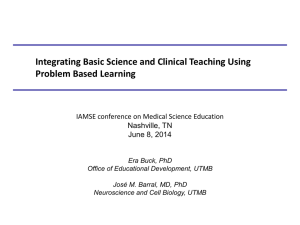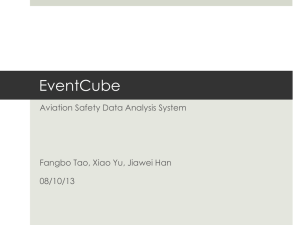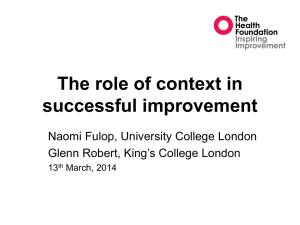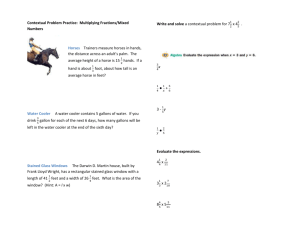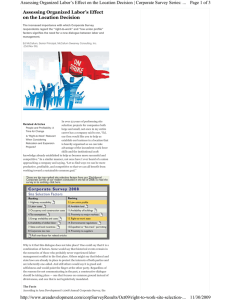Module 3: Fit to the context and existing capacity
advertisement
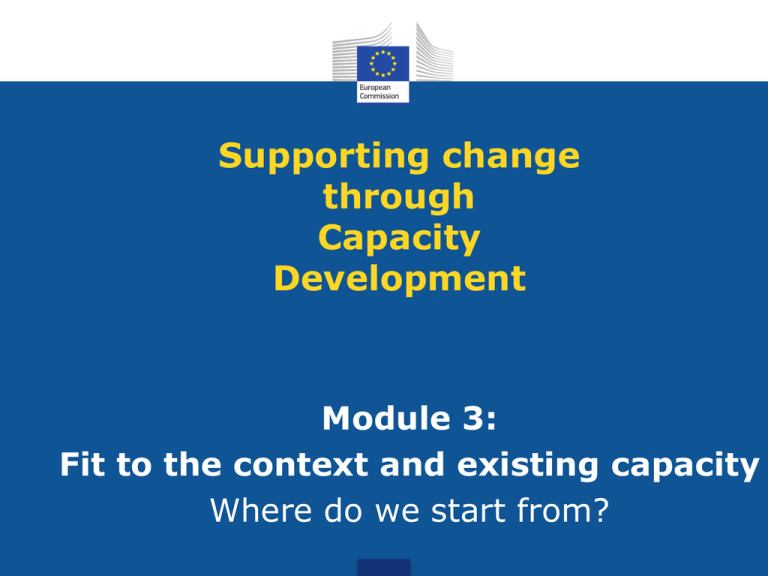
Supporting change through Capacity Development Module 3: Fit to the context and existing capacity Where do we start from? Quality Criteria are guiding CD support 1. Fit to the context and existing capacity 5. Appropriate PIAs 2. Adequate demand, and ownership Quality EC Capacity Development 4. Harmonised support 3. Clear link to results and outcomes How the QC are applied in PCM The EC has developed tools for monitoring the quality implementation, which provide the framework for good design • • • • of The QSG (Quality Grid) The ROM The annual EAMR RAC evaluation The novelty of the EC approach lies in translating the Development Effectiveness principles into quality criteria to be mainstreamed into the EC Project Cycle and be monitored regularly 3 CD Quality Grid requirement: 1. Fit to the context and existing capacity 1.1 Are there critical constraints in the context which could make TC ineffective and impede achieving the purpose of the TC? If yes, how will they be addressed? 1.2 Has the existing capacity of the concerned partner(s) organisation(s) been assessed? Is it confirmed that the objectives and the scope of the TC support match the existing capacity to lead, manage and absorb the support? 1.3 How have similar programmes and types of TC worked in the current context? Please indicate which, if any, and why they have been successful. Why is this criteria important? Don’t waste resources Avoid ‘parallelism’ Best fit to context and capacity 5 Assessment - a key task: Initial assessment • Throughout the life of programme, not just design • To ensure relevance, determine feasibility, allow for adaptation, monitor progress • Ensure linkages with the (policy) dialogue Design Reassessment Re-design And so on 6 Assessing Context Contextual factors beyond influence Recurrent inputs Internal resources Capacity Outputs Outcomes CD processes Contextual factors and actors within influence Wider impact Three context assessment tools • Political Economy Analysis: • Methodology for analysing the “space” for reform • Specific guidance available: PPCM and Cap4Dev practice group • Will generate drivers, opportunities and constraints • Opportunity Framework: • A way to look at broad geo-political and socio-economic processes providing reform “windows” • Stakeholder Mapping • Sector Governance mapping produced by EC in sector guidance • Multiple tools and methods available on internet/ resource books • Power/influence, formal/informal • BUT NO SUBSTITUTE FOR SUSTAINED ENGAGEMENT AND BUILDING OF SOUND RELATIONSHIPS Assessing Capacity Contextual factors beyond influence Recurrent inputs Internal resources Capacity Outputs CD processes Contextual factors and actors within influence Outcomes Wider impact Assessing Capacity: multiple purposes • As a design tool to build results framework for an intervention • As a self-administered health check for organisational learning and ownership for change • As a way to engage in a dialogue on need for change; find out who is doing what and where to start • As a monitoring tool to track progress over time • As a performance management tool to incentivise performance improvement • As a tool to determine compliance and eligibility against set norms and standards • Examples of assessment tools Purpose Instruments/tools Organisational/ • EC Toolkit for CD Sector Assessment • ECDPM 5Cs • McKinsey’s 7s, Weisbord’s 6 boxes and OCAT • IDRC Organisational Assessment • EU 7 key areas of sector assessment PFM reform and compliance / Governance assessment • • • • • EU 4 pillars PEFA ACBF Capacity Indicators CPIA/ World Bank Political-Economy Analysis Customised theme or sector specific • • • • UNOPS/ OECD Procurement Assessment County Capacity Readiness Assessment UNDP Disaster Risk Reduction …and many many more. 11 “Functional” and “political” dimension of capacity Functional dimension “Political” dimension Main unit of Focus on functional analysis? task-and-work system Focus on powerand-loyalty systems Driving forces? A sense of norms, intrinsic motivation Sanctions and rewards, incentives Image of man? Employees caring for the organisation Individuals caring for themselves and their in-groups Change? Participative reasoning, finding best technical solution, orderly Internal conflict, coalition with powerful external agents, unpredictable Change efforts? Internal systems, structures, Incentives, change of key skills, technology etc staff, outsmarting opposition 12 Some Good Practice Tips • Keep it simple, avoid over-analysing, especially early on and risk to undermine trust and confidence • Avoid focusing just on gaps and weaknesses; build on strengths and understand why things are the way they are • Use and build on existing information, avoid intrusiveness • Encourage self-assessment to promote ownership/ learning • Watch out for assessment fatigue, timing crucial Depending on purpose, opportunity, stage of process; analysis can range from simple, “quick and dirty” through to comprehensive and analytical An incremental approach to assessment Where we are now Extension and improvement would look like … Can provide the basis for specifying capacity results And then the next level would be … Would maybe provide the basis for specifying the overall capacity objective Our capacity vision 14 What Role for the EC/ DPs? • Invest in dialogue and relationship building • Help build a constituency for change • Provide technical expertise with respect to techniques and approaches • Facilitate and support self-assessment • Help establish baseline data about current capacity to enable effective monitoring and evaluation of results • Explore opportunities to harmonise and align through coordination with other donors Your experiences with: • Context assessment as a continuous effort • Linking up with longer term development goals • Finding (neg. or pos.) incentives for CD • Cultural/historical influences on CD • Finding a constituency for change • Assessing the informal/political context
